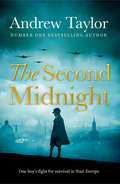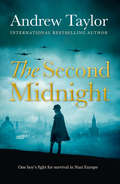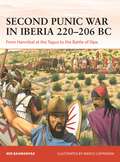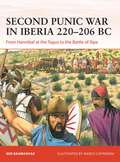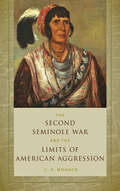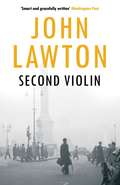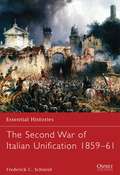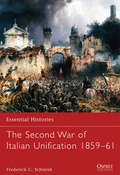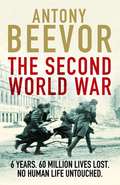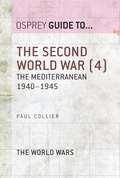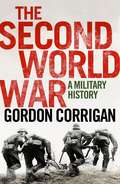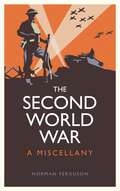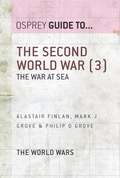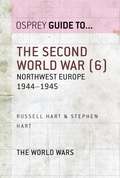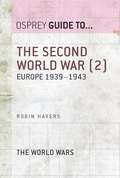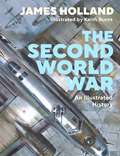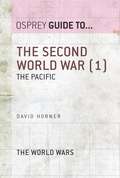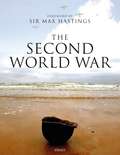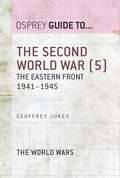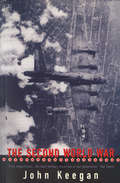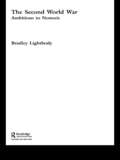- Table View
- List View
The Second Midnight
by Andrew TaylorFrom the No. 1 Sunday Times bestselling author comes a World War Two tale of one boy’s fight for survival in Nazi Europe
The Second Midnight
by Andrew TaylorFrom the international bestselling author comes a World War Two tale of one boy’s fight for survival in Nazi Europe
Second Punic War in Iberia 220–206 BC: From Hannibal at the Tagus to the Battle of Ilipa (Campaign #400)
by Mir BahmanyarThe first dedicated, illustrated study of the events of the Second Punic War in Iberia, which served as a launch pad for the Carthaginian invasion of Rome.Iberia was one of three crucial theatres of the Second Punic War between Carthage and Rome. Hannibal of Carthage's siege of Saguntum in 219 BC triggered a conflict that led to immense human and material losses on both sides, pitting his brother Hasdrubal against the Republican Roman armies seeking to gain control of the peninsula. Then, in 208 BC, the famous Roman general Scipio Africanus defeated Hasdrubal at Baecula, forcing Hasdrubal's army out of Iberia and on to its eventual annihilation at the Metaurus. In this work, military historian Mir Bahmanyar brings to life the key personalities and events of this important theatre of the war, and explains why the Roman victory at Baecula led to a strategic shift and Carthage's eventual defeat. It covers Scipio Africanus' brilliant victory at Ilipa in 206 BC, where he crushed the army of Mago Barca and Hasdrubal Gisco. Illustrated with maps, tactical diagrams, battlescene artworks and photographs, this work provides a gripping narrative of the large-scale battles fought in Iberia.
Second Punic War in Iberia 220–206 BC: From Hannibal at the Tagus to the Battle of Ilipa (Campaign #400)
by Mir BahmanyarThe first dedicated, illustrated study of the events of the Second Punic War in Iberia, which served as a launch pad for the Carthaginian invasion of Rome.Iberia was one of three crucial theatres of the Second Punic War between Carthage and Rome. Hannibal of Carthage's siege of Saguntum in 219 BC triggered a conflict that led to immense human and material losses on both sides, pitting his brother Hasdrubal against the Republican Roman armies seeking to gain control of the peninsula. Then, in 208 BC, the famous Roman general Scipio Africanus defeated Hasdrubal at Baecula, forcing Hasdrubal's army out of Iberia and on to its eventual annihilation at the Metaurus. In this work, military historian Mir Bahmanyar brings to life the key personalities and events of this important theatre of the war, and explains why the Roman victory at Baecula led to a strategic shift and Carthage's eventual defeat. It covers Scipio Africanus' brilliant victory at Ilipa in 206 BC, where he crushed the army of Mago Barca and Hasdrubal Gisco. Illustrated with maps, tactical diagrams, battlescene artworks and photographs, this work provides a gripping narrative of the large-scale battles fought in Iberia.
The Second Seminole War and the Limits of American Aggression
by C. S. MonacoThe Second Seminole War (1835;€“1842) was the last major conflict fought on American soil before the Civil War. The early battlefield success of the Seminoles unnerved US generals, who worried it would spark a rebellion among Indians newly displaced by President Andrew Jackson's removal policies. The presence of black warriors among the Seminoles also agitated southerners wary of slave revolt. A lack of decisive victories and a series of bad decisions;¢;‚¬;€?among them the capture of Seminole leader Osceola while under the white flag of truce;¢;‚¬;€?damaged the US Army's reputation at home and abroad. Desertion was rampant as troops contended with the subtropical Florida wilderness. And losses for the Seminoles were devastating; by the war's end, only a few hundred remained in Florida.In his ambitious study, C. S. Monaco explores the far-reaching repercussions of this bloody, expensive campaign. Taking an interdisciplinary approach, Monaco not only places this protracted conflict within a military context but also engages the various environmental, medical, and social aspects to uncover the war's true significance and complexity.By examining the Second Seminole War through the lenses of race, Jacksonian democracy, media and public opinion, American expansion, and military strategy, Monaco offers an original perspective on a misunderstood and often-neglected chapter in our history.
The Second Seminole War and the Limits of American Aggression
by C. S. MonacoThe Second Seminole War (1835;€“1842) was the last major conflict fought on American soil before the Civil War. The early battlefield success of the Seminoles unnerved US generals, who worried it would spark a rebellion among Indians newly displaced by President Andrew Jackson's removal policies. The presence of black warriors among the Seminoles also agitated southerners wary of slave revolt. A lack of decisive victories and a series of bad decisions;¢;‚¬;€?among them the capture of Seminole leader Osceola while under the white flag of truce;¢;‚¬;€?damaged the US Army's reputation at home and abroad. Desertion was rampant as troops contended with the subtropical Florida wilderness. And losses for the Seminoles were devastating; by the war's end, only a few hundred remained in Florida.In his ambitious study, C. S. Monaco explores the far-reaching repercussions of this bloody, expensive campaign. Taking an interdisciplinary approach, Monaco not only places this protracted conflict within a military context but also engages the various environmental, medical, and social aspects to uncover the war's true significance and complexity.By examining the Second Seminole War through the lenses of race, Jacksonian democracy, media and public opinion, American expansion, and military strategy, Monaco offers an original perspective on a misunderstood and often-neglected chapter in our history.
Second Violin: An Inspector Troy Thriller (Inspector Troy series #6)
by John LawtonWritten by 'a sublimely elegant historical novelist as addictive as crack' (Daily Telegraph), the Inspector Troy series is perfect for fans of Le Carré, Philip Kerr and Alan Furst.1938.The Germans take Vienna without a shot being fired. Covering Austria for the English press is a young journalist named Rod Troy. Back home his younger brother joins the CID as a detective constable. Two years later tensions are rising and 'enemy aliens' are rounded up in London for internment. In the midst of the chaos London's most prominent rabbis are being picked off one by one and Troy must race to stop the killer.
The Second War of Italian Unification 1859–61 (Guide to...)
by Frederick C. SchneidThe culmination of decades of nationalist aspiration and cynical Realpolitik, the Second War of Italian Unification saw Italy transformed from a patchwork of minor states dominated by the Habsburg Austrians into a unified kingdom under the Piedmontese House of Savoy. Unlike many existing accounts, which approach the events of 1859–61 from a predominantly French perspective, this study draws upon a huge breadth of sources to examine the conflict as a critical event in Italian history. A concise explanation of the origins of the war is followed by a wide-ranging survey of the forces deployed and the nature and course of the fighting – on land and at sea – and the consequences for those involved are investigated. This is a groundbreaking study of a conflict that was of critical significance not only for Italian history but also for the development of 19th-century warfare.
The Second War of Italian Unification 1859–61 (Essential Histories)
by Frederick C. SchneidThe culmination of decades of nationalist aspiration and cynical Realpolitik, the Second War of Italian Unification saw Italy transformed from a patchwork of minor states dominated by the Habsburg Austrians into a unified kingdom under the Piedmontese House of Savoy. Unlike many existing accounts, which approach the events of 1859–61 from a predominantly French perspective, this study draws upon a huge breadth of sources to examine the conflict as a critical event in Italian history. A concise explanation of the origins of the war is followed by a wide-ranging survey of the forces deployed and the nature and course of the fighting – on land and at sea – and the consequences for those involved are investigated. This is a groundbreaking study of a conflict that was of critical significance not only for Italian history but also for the development of 19th-century warfare.
The Second War of Italian Unification 1859–61 (Essential Histories #74)
by Frederick C. SchneidThe culmination of decades of nationalist aspiration and cynical Realpolitik, the Second War of Italian Unification saw Italy transformed from a patchwork of minor states dominated by the Habsburg Austrians into a unified kingdom under the Piedmontese House of Savoy. Unlike many existing accounts, which approach the events of 1859–61 from a predominantly French perspective, this study draws upon a huge breadth of sources to examine the conflict as a critical event in Italian history. A concise explanation of the origins of the war is followed by a wide-ranging survey of the forces deployed and the nature and course of the fighting – on land and at sea – and the consequences for those involved are investigated. This is a groundbreaking study of a conflict that was of critical significance not only for Italian history but also for the development of 19th-century warfare.
The Second World War
by Antony BeevorA magisterial, single-volume history of the greatest conflict the world has ever known by our foremost military historian. ***** The Second World War began in August 1939 on the edge of Manchuria and ended there exactly six years later with the Soviet invasion of northern China. The war in Europe appeared completely divorced from the war in the Pacific and China, and yet events on opposite sides of the world had profound effects. Using the most up-to-date scholarship and research, Beevor assembles the whole picture in a gripping narrative that extends from the North Atlantic to the South Pacific and from the snowbound steppe to the North African Desert. Although filling the broadest canvas on a heroic scale, Beevor's The Second World War never loses sight of the fate of the ordinary soldiers and civilians whose lives were crushed by the titanic forces unleashed in the most terrible war in history.
The Second World War: The Mediterranean 1940–1945 (Guide to...)
by Paul CollierThis book explores the idea that the Mediterranean theater of the Second World War was the first truly modern war. It was a highly mobile conflict, in which logistics were a critical and often deciding factor, and from the very beginning a close relationship between the land, sea, and air elements was vital. Victory could not be achieved by either side unless the three services worked in intimate cooperation. Each side advanced and withdrew across 1,000 miles of desert until the Axis forces were decisively defeated at El Alamein in 1942.
The Second World War: A Military History
by Gordon CorriganIn this major new history, Gordon Corrigan argues that what we call the Second World War was in fact two separate conflicts: one against Germany (and, for a while, Italy) in Western Europe, Soviet Russia and North Africa; the other against Japan in the Far East and Pacific. Each conflict had distinct causes and had to be fought in different ways against very different enemies, who rarely, if ever, coordinated their efforts. This is a new and cogent account of an immense, exhausting six-year conflict that continues to fascinate. Corrigan examines the agendas of the warring nations and offers fresh and vivid interpretations; Britain's own part in the war comes in for particularly close scrutiny: militarily, the British suffered an agonising series of defeats before the tide turned. The country emerged economically broken, with the loss of her empire a virtual certainty. The Second World War is vast in its erudition and epic in its execution. It will change forever the way we think about the titanic conflicts that dominated the years 1939 to 1945.
The Second World War: A Miscellany
by Norman FergusonFrom the horrors of the Holocaust to the D-Day landings, the Second World War changed the political, social and economic structure of the world. Through its battles, aircraft, weapons, soldiers, campaigns and heroes, this miscellany is a compelling guide to one of the most destructive and all-encompassing wars the world has ever seen.
The Second World War: The War At Sea (Guide To... Ser.)
by Alastair FinlanThis volume provides a comprehensive guide to three major theatres of combat; the battles for the Atlantic, the war in the Mediterranean and the contest in the Indian Ocean. The war at sea was a vital contest, which if lost would have irreversibly altered the balance of the military forces on land. The sea lanes were the logistical arteries of British and subsequent Allied armies fighting on the three continents of Africa, Asia and Europe. The Second World War was ultimately won by land forces but it could always have been lost at sea.
The Second World War: Northwest Europe 1944–1945 (Guide to...)
by Stephen A. HartThis book examines the seminal Northwest Europe campaign of the Second World War. This hard-fought campaign conducted by the Western Allies against the Germans during 1944-45 represented, for the former, the decisive theatre of the entire Second World War. From the desperate and risk-laden D-Day landings on 6 June 1944 to the rapid charge through western and central Germany in the last weeks of the war, American, British, Canadian and French military forces took on and defeated the German military. This victory ensured that the scourge of Nazism was finally expunged from the face of Europe.
The Second World War: Europe 1939–1943 (Guide to...)
by Robin HaversWhile many of the participants were the same as the First World War, this conflict was far more than a re-match of 1914-1918. The Second World War was even more destructive than the first and the added ideological element meant that this war was far crueller.This book details the first four years of the war in Europe. It discusses how and why Hitler's resurgent Germany plunged into war, and examines the German successes against Poland, France and the Low Countries.
The Second World War: An Illustrated History (The\ladybird Expert Ser. #10)
by James HollandDiscover the story of the Second World War brought to life in full colour by renowned historian James Holland and award-winning artist Keith Burns'A fully immersive experience. A comprehensive yet fast-paced and gripping insight into the Second World War. Not just accessible, but riveting. An absolute pleasure to read' GET HISTORY'A ground-breaking collaboration between bestselling historian James Holland and award-winning artist Keith Burns presents the war in full colour, bringing the text vividly to life' HISTORY OF WAR__________From the great cities of Europe to the jungles of Burma, and from the deserts of North Africa to the remote islands of the South Pacific and the freezing waters of the Arctic, the Second World War touched every continent and ocean on the planet. And from the Blitzkrieg to the atom bomb, the fighting fuelled new technological development on land, at sea and in the air at a ferocious pace. Our future was forged by war.Combining compelling personal stories with a clear and accessible appreciation of the strategic and operational battle for supremacy between the Allies and the Axis powers, bestselling historian James Holland weaves an irresistible narrative, with over 250 illustrations by acclaimed artist Keith Burns, commissioned specially for this project.Together, they bring events in The Second World War: An Illustrated History to life with stunning drama and dynamism.Over five years in the making, their groundbreaking collaboration has produced a unique and unforgettable account of the most extraordinary events the world has ever seen.__________'Gripping text, masterful imagery and touching personal stories make this a must-buy for anyone with an interest in World War Two' CLASSIC MILITARY VEHICLES'A bold attempt to expand the market for military history . . . aimed at a general reader who wants to get an overall grasp of a massive subject . . . this is an impressive achievement' BOOKBRUNCH
The Second World War: The Pacific (Guide to... #18)
by David HornerThe war in the Pacific began with the Japanese attack on Pearl Harbor on 7 December 1941 and ended with the atomic bombs on Hirsoshima and Nagasaki in August 1945, which led to the surrender in Tokyo Bay on 2 September 1945. It was a war of great naval battles, such as those in the Coral Sea, at Midway, and at Leyte and of grim jungle battles, at Guadalcanal, New Guinea and Burma. This book explores the many facets of this complicated conflict, which reshaped the face of Asia and splintered forever European invincibility as a colonial power.
The Second World War
by David Horner Robin Havers Alastair Finlan Mark J Grove Philip D Grove Paul Collier Geoffrey Jukes Russell Hart Stephen A. Hart Max HastingsThe period from 1939 to 1945 saw some of the most devastating and remarkable events in living memory. Labouring beneath a daily burden of fear, sacrifice, deprivation and uncertainty, soldiers and civilians of all nationalities were driven to extremes of selfless loyalty, dogged determination or bitter cruelty by the demands of a world at war. This book tells the stories of the men and women who lived and died during the Second World War, from politicians to factory workers, and from High Command to the conscripted men on the front lines. The experience of war is brought to life through a wealth of contemporary documentation, private writings and historical research, whilst the political, military and historical significance of the war is assessed and examined. From Europe's Western and Eastern Fronts to the war at sea, and from the Pacific to the Mediterranean and North Africa, every fighting front of the Second World War is covered in this truly comprehensive volume.
The Second World War: Northwest Europe, 1944-1945 (Essential Histories Ser. #No. 18)
by David Horner Robin Havers Professor Alastair Finlan Mark J Grove Philip D Grove Paul Collier Geoffrey Jukes Russell Hart Stephen A. Hart Max HastingsThe period from 1939 to 1945 saw some of the most devastating and remarkable events in living memory. Labouring beneath a daily burden of fear, sacrifice, deprivation and uncertainty, soldiers and civilians of all nationalities were driven to extremes of selfless loyalty, dogged determination or bitter cruelty by the demands of a world at war. This book tells the stories of the men and women who lived and died during the Second World War, from politicians to factory workers, and from High Command to the conscripted men on the front lines. The experience of war is brought to life through a wealth of contemporary documentation, private writings and historical research, whilst the political, military and historical significance of the war is assessed and examined. From Europe's Western and Eastern Fronts to the war at sea, and from the Pacific to the Mediterranean and North Africa, every fighting front of the Second World War is covered in this truly comprehensive volume.
The Second World War: The Eastern Front 1941–1945 (Guide to... #24)
by Geoffrey JukesIn 1940, fresh from the success in France, Hitler turned his attention to the East. In this volume Geoffrey Jukes explains what led to Hitler's decision to instigate the invasion of the Soviet Union (Operation Barbarossa) and offers a concise account of the campaign that followed. The Germans expected to conquer Russia in only four months, but at Stalingrad and then Kursk the Russians fought back. At a human cost of 27 million Soviet lives Hitler was forced into a humiliating retreat and Russia emerged from the war as a super power ready to take on the capitalist world.
The Second World War (Cassell History Of Warfare Ser. #5)
by John KeeganIn this comprehensive history, John Keegan explores both the technical and the human impact of the greatest war of all time. He focuses on five crucial battles and offers new insights into the distinctive methods and motivations of modern warfare. In knowledgable, perceptive analysis of the airborne battle of Crete, the carrier battle of Midway, the tank battle of Falaise, the city battle of Berlin, and the amphibious battle of Okinawa, Keegan illuminates the strategic dilemmas faced by the leaders and the consequences of their decisions on the fighting men and the course of the war as a whole.
The Second World War: Ambitions to Nemesis
by Bradley LightbodyBradley Lightbody presents a fascinating and accessible history of the Second World War in its global context. Examining the war around general themes from ambition and advance, through expansion and containment, to rout and victory, The Second World War covers all the major theatres and events of the war. From the origins and background to the war to its aftermath and legacy, The Second World War covers: * the pre-war ambitions of Italy, Germany and Japan* the outbreak of the war in Poland* the 'Phoney War'* Blitzkrieg, the Fall of France and the Battle of Britain* Pearl Harbour* the war in North Africa and El Alamein* the final solution* D-Day, the liberation of Italy and deliverance from the concentration camps* the bombing of Hiroshima and Nagasaki. This book provides a comprehensive overview of the global ambitions and the global warfare that was the Second World War, making it essential reading for all students of twentieth century world history.
The Second World War: Ambitions to Nemesis
by Bradley LightbodyBradley Lightbody presents a fascinating and accessible history of the Second World War in its global context. Examining the war around general themes from ambition and advance, through expansion and containment, to rout and victory, The Second World War covers all the major theatres and events of the war. From the origins and background to the war to its aftermath and legacy, The Second World War covers: * the pre-war ambitions of Italy, Germany and Japan* the outbreak of the war in Poland* the 'Phoney War'* Blitzkrieg, the Fall of France and the Battle of Britain* Pearl Harbour* the war in North Africa and El Alamein* the final solution* D-Day, the liberation of Italy and deliverance from the concentration camps* the bombing of Hiroshima and Nagasaki. This book provides a comprehensive overview of the global ambitions and the global warfare that was the Second World War, making it essential reading for all students of twentieth century world history.
